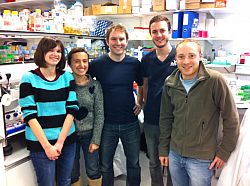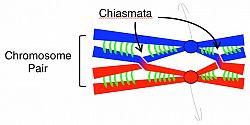Geneticist gets €1.7m for five-year DNA project
An up-and-coming geneticist at Sussex has been awarded a research grant worth €1.7 million to analyse the process of DNA repair responsible for the passing of genes from parents to children.
 Dr Matt Neale's lab team. From left to right - Rachal Allison, Dr Valerie Garcia, Dr Matt Neale, Dominic Johnson and Dr Steve Gray.
Dr Matt Neale's lab team. From left to right - Rachal Allison, Dr Valerie Garcia, Dr Matt Neale, Dominic Johnson and Dr Steve Gray.
 In this cartoon, a pair of chromosomes (one red, one blue) have undergone two HR events (one on the left and one on the right of the figure). Each ‘chiasma’ marks the site of a reassortment of the genetic information between the two chromosomes.
In this cartoon, a pair of chromosomes (one red, one blue) have undergone two HR events (one on the left and one on the right of the figure). Each ‘chiasma’ marks the site of a reassortment of the genetic information between the two chromosomes.
The European Research Council (ERC) has awarded Dr Matt Neale a Starting Grant, which is specifically designed to support those in the early years of their research career.
He begins the five-year project in January 2013.
By conducting studies in a common yeast used for making bread and beer, Dr Neale, a Research Fellow in the Genome Damage and Stability Centre (GDSC), hopes to better understand a method of DNA repair called homologous recombination, or HR.
In order to repair a damaged DNA sequence, HR copies information from an intact undamaged DNA region. In addition to repairing spontaneous DNA damage, HR is used extensively during gametogenesis – the process by which we produce fertile sperm and eggs.
Dr Neale explains: “About 200 DNA breaks are purposely created – and repaired – within each maturing gamete cell.
“In this context, HR is not just a DNA repair mechanism, but also a method that has evolved to drive interaction and genetic exchange between the two copies of each chromosome that we inherited from our parents. The results are sperm and eggs that each have a unique mixture of our own genetic information and, by extension, that of our parents.
“The generation of these unique combinations explains why siblings have unique appearance and characteristics.
“Without HR occurring during gamete formation, we would be completely infertile.”
Understanding processes like HR could also help with the diagnosis and treatment of cancer patients.
Dr Neale says: “When HR goes wrong unwanted chromosome rearrangements can arise, creating daughter cells with chromosome regions that are duplicated or missing - a classic hallmark of a cancer cell.
“Projects like this could impact how well we can understand and interpret the causes and consequences of lost gene and cellular function within our own bodies - improving, for example, the diagnosis and treatment of patients.”
Dr Neale will use the grant to support the research training of technical, postgraduate and postdoctoral researchers, to develop new methods of analysis, and to foster collaborative links both within and outside of the GDSC.
He and his team will use Saccharomyces cerevisiae – the yeast used in making bread and beer – as a powerful laboratory model to investigate some of the fundamental processes of DNA repair and HR that are evolutionarily conserved from bacteria through to humans.
Dr Neale says: “Working in this simple model species allows complex genetic and molecular questions to be investigated, revealing answers to questions that would otherwise prove difficult in complex multicellular organisms like humans.”
Dr Neale is the third Sussex researcher to be awarded a Starting Grant by the ERC in 2012. Physicists Dr Jeff Hartnell and Dr David Seery were both successful in their bids earlier in the year.
